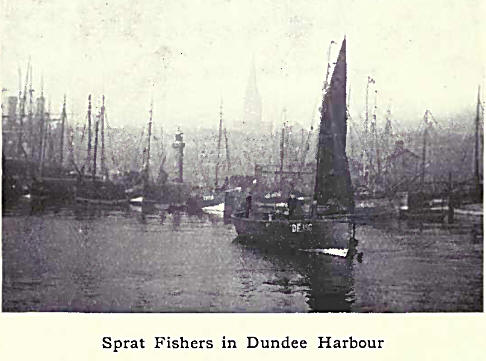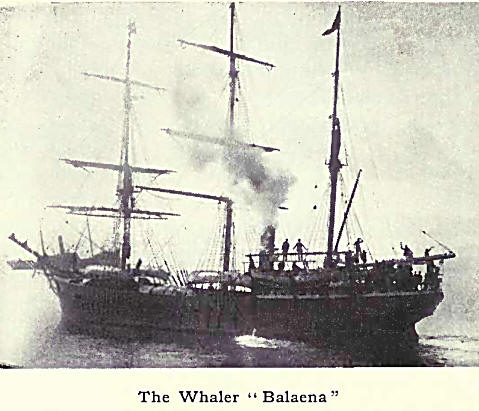|
Fish are caught off
all our Scottish coasts, but the east is far more important than the
west, partly because the North Sea is one of the finest fishing
grounds in the world, and partly owing to the remoteness from
markets of the north-western and Hebridean ports. The relative
importance of the coasts in the fishing industry for 1910 will be
seen from the following figures:—
East Coast—total
value of all fish landed £2,225,170
Orkney and Shetland „ „ 606,442
West Coast „ „ 338,535
Grand total £3,170,147
The value of the
shell fish caught on the West Coast exceeded, however, that on the
East by £13,617.
Under the Fishery
Board of Scotland the whole country is divided into a number of
districts, each under the supervision of a fishery officer. Each
district includes a number of “creeks” or subsidiary ports. The
“creeks” of Forfarshire and a few in Kincardineshire are in the
Montrose district, those in our county being Dundee, Broughty Ferry,
Westhaven, Easthaven, Arbroath, Auchmithie, Usan, Ferryden, and
Montrose. The chief kinds of fish landed in Forfarshire in 1910
arranged in order of market value were haddock, cod, herring, sole,
plaice, whiting, mussels, turbot, crabs, which, with less important
varieties, reached a total value of £71,382.

Forfarshire fishermen
prosecute their calling in the Firth of Tay, where salmon, sprats,
sparling, etc. are taken; on the ocean foreshore; but chiefly far
out at sea, where operations are carried on from 16 to 80 miles in a
south-easterly direction, the principal fishing-grounds being from
40 to 60 miles off shore.
In 1910 Dundee showed
an increase of over £5000 in the value of fish landed by trawlers,
the chief kinds of fish brought into the port being haddocks,
codlings, whitings, flat-fish, and sprats. Though not the
headquarters of the Forfarshire fisheries, Dundee receives half of
the entire “take” of the Montrose district.
The value of
shell-fish landed at Broughty Ferry far exceeded that of other ports
in the district, but in 1900 for the first time in living memory no
boats were fitted out for the summer herring fishing. The fishermen
of Westhaven and Easthaven are chiefly engaged in the capture of
salmon, lobsters, and crabs. Arbroath occupies the third place
amongst the fishing stations of Forfarshire, and Montrose the
second, although the two ports taken together land only one half as
many fish as are brought into Dundee.
While the fishing
industry of Scotland increases year by year, some significant
changes are taking place in the number of vessels engaged and in the
methods of capture adopted. In 1908 the entire fishing fleet
consisted of 11,576 craft of all kinds with a value of £2,029,384;
but in 1910, when the latest report was issued, the number of boats
had diminished to 9724, while their value had increased to
£5,439,857. The reason is that smaller vessels propelled by sail or
oar are rapidly giving place to larger and more valuable ships with
steam or motor power. Nevertheless, 83 per cent, of fishing boats
are still of the older type.
Though these changes
are fraught with good to the whole community, there are certain
aspects of them that are disadvantageous. Year by year it is
becoming harder for owners of the small kinds of craft to compete
with larger, more expensive, and more effective vessels owned by
wealthy companies; and, moreover, relatively fewer men can now find
employment. The result is a tendency for unemployed fishermen to
leave the picturesque fishing village with its brown sails and its
yellow sands, and seek work in the larger fishing ports or in great
centres of population, where they but increase the industrial
pressure. Hence there is a movement on foot to obtain state aid for
fishermen that will enable them to acquire motor boats and so
compete with mechanically propelled vessels of greater bulk.
Occupations ancillary
to the fisheries are chiefly those in connection with the curing and
packing of herrings and certain kinds of white fish. There is
employment for a whole army of curers, coopers, gutters, packers,
clerks, labourers, carters, and hawkers. In 1910, 2525 people were
engaged in the fishery district of Montrose.
In addition to the
estuarine and inshore capture of salmon, the North Esk and the South
Esk have valuable stations near their mouths. Both salmon and sea
trout are caught further up these rivers, while their upper reaches
and the numerous other streams and the lochs of the county afford
ample sport to the angler for trout and char.
Dundee has long been
distinguished as the headquarters in the country of the whale and
seal fishing which used to be prosecuted chiefly in the waters of
Greenland. In the earlier days of the industry, whale fishing was
carried on in sailing vessels, and about nine of these left the port
annually for the Arctic regions. An important advance took place in
1858, when steamers were employed. At first only five steamships
sailed from Dundee, but ten years later their number had increased
to eleven. The most prosperous year in the history of the Dundee
seal and whale fishing was 1874, when eleven vessels captured 44,087
seals and 190 whales, yielding 1420 tons of oil and 1436 cwts. of
whalebone, the whole valued at £106,500.

Seal fishing is now
regarded as unprofitable, and whaling (with far less satisfactory
results than formerly) has been continued only on account of the
high price obtained for whalebone. In 1874 this commodity was worth
£750 (Per ton) but as much as £2900 per ton has been paid for it,
while the price, which fluctuates according to supply and demand,
ranges from £1400 to £2500.
Whale oil, which used
to fetch £50 per ton, has fallen to £20, owing to the introduction
and ever-increasing use of mineral oils.
The Dundee whaling
fleet has in consequence of these changes diminished to eight
vessels. The gradual extinction of the whale and the difficulty
experienced in capturing a sufficient number to pay expenses will no
doubt in time cause the trade to die out altogether.
The preparation of
oil and the tanning and dressing of sealskins are industries proper
to Dundee in connection with these fisheries. |

